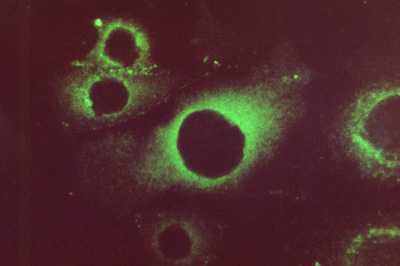AMD Projects: Improving Surveillance of Vaccine-preventable Diseases

AMD methods will help scientists visualize the whole genome structure of RNA viruses, like rubella, to improve their understanding of how RNA viruses spread.
CDC monitors the spread of both vaccine-preventable diseases and non-vaccine-preventable diseases. Some of the vaccine-preventable diseases caused by RNA viruses include measles, mumps, rubella, and polio. These viruses use RNA as their genetic material. While similar in structure to DNA, RNA is more variable and requires additional steps for genome sequencing (determining the genetic code).
The sequence and structure of the genomic RNA varies between RNA viruses and sometimes even within strains of the same virus. This makes developing a standard process for genome sequencing more challenging. What works for organisms that have larger DNA genomes, such as bacteria and DNA viruses, may not work for smaller organisms, such as RNA viruses. However, being able to see the whole genomic picture greatly increases our understanding of all of these pathogenic organisms. Current methods for obtaining the entire genetic make-up of these smaller, highly variable viruses involve older, less efficient technologies, which severely limit the quantity of information available for scientists to analyze. By increasing the number of complete genomic sequences for RNA viruses, we can greatly improve our understanding of how these viruses spread, how diverse they are, and where viruses in outbreaks come from.
This study will use advanced techniques and processes to help scientists more quickly identify the RNA viruses that cause disease outbreaks, as well as obtain their complete genomic information. These methods also will support faster detection of previously unknown viruses and speed up the development and improvement of vaccines to prevent diseases.
CDC will share what we learn with international partners and state public health laboratories. The techniques developed through this project also will be useful for analyzing other viral pathogens.
Project Update
Since the project began, investigators used advanced molecular detection (AMD) technologies to develop and implement a viral genomics pipeline (VGP), a combination of standardized laboratory methods and user-friendly computer analyses. The VGP has been applied to a range of important viral vaccine-preventable diseases, such as measles, polio, rubella, and rotavirus. The additional genetic information allows investigators to better track the sources of outbreaks, in the United States and worldwide. The VGP was developed as an open system, allowing easy improvement and application to other important viral diseases, such as those that cause respiratory and gastrointestinal illnesses.
In the next phase of the work, the VGP will be shared with state public health laboratories, through technology transfer and training, starting with state laboratories that participate in the Association of Public Health Laboratories (APHL)’s Vaccine Preventable Disease Reference Centers Program. The availability of the VGP will improve state capacity to respond to important disease threats.
- Page last reviewed: March 22, 2016
- Page last updated: March 22, 2016
- Content source:


 ShareCompartir
ShareCompartir